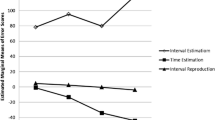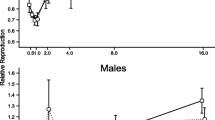Abstract
Ability to perceive fast-paced events (a range of short intervals) is one of the important cognitive skills in humans. The underlying mechanism of this ability still remains elusive. We designed a study to investigate the subjective perception of short-intervals (10, 20, 60 and 120 s) in a cohort of healthy young male and female university students. The subjects estimated the time intervals, prospectively using time production (TP) and verbal estimation (VE) methods. Of the four tested intervals, subjects produced 60 s close to accuracy than other intervals. The intervals were overproduced and underestimated with TP and VE, respectively. Males estimated 60 s more accurately than females. In all subjects, verbal estimates of 60 and 120 s were positively correlated with sleep duration. The duration of exposure to direct sunlight was significantly correlated with the verbal estimation of 60 and 120 s intervals in females. It is concluded that humans track passage of short intervals fairly accurately and 60 s might be the interval that is judged more accurately in males. This behavior could be ascribed to the interval timer that might have evolved with frequently used verbal expression, i.e., “wait a minute please!” In addition, the factors, such as gender, sleep duration and length of sunlight exposure might considerably modulate human abilities to sense time.





Similar content being viewed by others
References
Verginia M (1996) Setting a biological stopwatch. Science 271:905–906
Harrington DL, Haaland KY, Knight RT (1998) Cortical networks underlying mechanisms of time perception. J Neurosci 18:1085–1095
Pouthas V, Maquet P, Garnero L, Ferrandez AM, Renault B (1999) Neural basis of time estimation: a PET and ERP study. Electroencephalogr Clin Neurophysiol Suppl 50:598–603
Matell MS, Meck WH (2000) Neuropsychological mechanisms of interval timing behavior. Bioessays 22:94–103
Aschoff J (1998) Human perception of short and long time intervals: its correlation with body temperature and the duration of wake time. J Biol Rhythms 3:437–442
Zakay D (1990) The evasive art of subjective time measurement: some methodological dilemmas. In: Block RA (ed) Cognitive models of psychological time. Erlbaum, Hillsdale, pp 59–84
Rammsayer TH (2001) Ageing and temporal processing of durations within the psychological present. Eur J Cogn Psychol 13:549–565
Block RA, Hancock PA, Zakay D (2000) Sex differences in duration judgments: a meta-analytic review. Mem Cognit 28:1333–1346
Pati AK, Gupta S (1994) Time estimation circadian rhythm in shift workers and diurnally active humans. J Biosci 19:325–330
Katsuura T, Yasuda T, Shimomura Y, Iwanaga K (2007) Effects of monochromatic light on time sense for short intervals. J Physiol Anthropol 26:95–100
Morita T, Nishijima T, Tokura H (2005) Time sense for short intervals during the follicular and luteal phases of the menstrual cycle in humans. Physiol Behav 85:93–98
Morita T, Fukui T, Morofusi M, Tokura H (2007) Subjective time runs faster under the influence of bright rather than dim light conditions during the forenoon. Physiol Behav 91:42–45
Klein LC, Corwin EJ, Stine MM (2003) Smoking abstinence impairs time estimation accuracy in cigarette smokers. Psychopharmacol Bull 37:90–95
Kuriyama K, Uchiyama M, Suzuki H, Tagaya H, Ozaki A, Aritake S, Kamei Y, Nishikawa T, Takahashi K (2003) Circadian fluctuation of time perception in healthy human subjects. Neurosci Res 46:23–31
Pande B, Rathod G, Vaidya N, Nag C, Parganiha A, Pati AK (2011) Non-auditory effect of community noise on interval timing in humans: an exploration. Biol Rhythm Res 43:585–601
Espinosa-Fernández L, Miró E, Cano MC, Buela-Casal G (2003) Age-related changes and gender differences in time estimation. Acta Psychol 112:221–232
Kuriyama K, Uchiyama M, Suzuki H, Tagaya H, Ozaki A, Aritake S, Shibui K, Xin T, Lan L, Kamei Y, Takahashi K (2005) Diurnal fluctuation of time perception under 30-h sustained wakefulness. Neurosci Res 53:123–128
Kleitman N (1939) Sleep and wakefulness. University of Chicago, Chicago
Valdez P, Reilly T, Waterhouse J (2008) Rhythms of mental performance. Mind Brain Educ 2:7–16
Horne JA, Östberg O (1976) A self-assessment questionnaire to determine morningness–eveningness in human circadian rhythms. Int J Chronobiol 4:97–110
Roenneberg T, Wirz-Justice A, Merrow M (2003) Life between clocks: daily temporal patterns of human chronotypes. J Biol Rhythms 18:80–90
Hoddes E, Zarcone V, Smythe H, Philips R, Dement WCI (1973) Quantification of sleepiness: a new approach. Psychophysiol 10:431–436
Pande B, Pati AK (2010) Overestimation/underestimation of time: concept confusion hoodwink conclusion. Biol Rhythm Res 41:379–390
Morofushi M, Shinohara K, Kimura F (2001) Menstrual and circadian variations in time perception in healthy women and women with premenstrual syndrome. Neurosci Res 41:339–344
Sayette MA, Loewenstein G, Kirchner TR, Travis T (2005) Effects of smoking urge on temporal cognition. Psychol Addict Behav 19:88–93
Perbal S, Droit-Volet S, Isingrini M, Pouthas V (2002) Relationships between age-related changes in time estimation and age-related changes in processing speed, attention, and memory. Aging Neuropsychol Cogn 9:201–216
Rakitin BC, Gibbon J, Penney TB, Malapani C, Hinton SC, Meck WH (1998) Scalar expectancy theory and peak-interval timing in humans. J Exp Psychol Anim Behav Process 24:15–33
Wright K (2002) Times of our lives. Sci Am 287:59–65
Blatter K, Cajochen C (2007) Circadian rhythms in cognitive performance: methodological constraints, protocols, theoretical underpinnings. Physiol Behav 90:196–208
Block RA, Zakay D, Hancock PA (1998) Human aging and duration judgments: a meta-analytic review. Psychol Aging 13:584–596
Pouthas V (1999) Le temps de la conscience, la conscience du temps. J Soc Biol 193:411–420
Wearden JH, Edwards H, Fakhri M, Percival A (1998) Why “sounds are judged longer than lights”: application of a model of the internal clock in humans. Q J Exp Psychol 51B:97–120
Droit-Volet S, Tourret S, Wearden J (2004) Perception of the duration of auditory and visual stimuli in children and adults. Q J Exp Psychol 57A:797–818
Goldstone S, Lhamon WT (1972) Auditory-visual differences in human temporal judgment. Percept Mot Skills 34:623–633
Goldstone S, Lhamon WT (1974) Studies of auditory–visual differences in human timing judgment: 1. Sounds are judged longer than lights. Percept Mot Skills 39:63–82
Penney T, Allan L, Meck W, Gibbon J (1998) Memory mixing in duration bisection. In: Rosenbaum DA, Collyer CE (eds) Timing of behavior: neural, computational and psychophysical perspectives. MIT Press, Cambridge, pp 165–193
Penney TB, Gibbon J, Meck W (2000) Differential effects of auditory and visual signals on clock speed and temporal memory. J Exp Psychol Hum Percept Perform 26:1770–1787
Rammsayer T, Lustnauer S (1989) Sex differences in time perception. Percept Mot Skills 68:195–198
Eisler H, Eisler A (1992) Time perception: effects of sex and sound intensity on scales of subjective durations. Scand J Psychol 33:339–358
Hancock PA, Vercruyssen M, Rodenburg GJ (1992) The effect of gender and time-of-day on time perception and mental workload. Curr Psychol Res Rev 11:203–225
Roeckelein JE (1972) Sex differences in time estimation. Percept Mot Skills 35:859–862
Marmaras N, Vassilakis P, Dounias G (1995) Factors affecting accuracy of producing time intervals. Percept Mot Skills 80:1043–1056
Adkins CJ (1972) Verbal estimations of time at four spatial distances. Percept Mot Skills 35:411–418
Hornstein AD, Rotter GS (1969) Research methodology in temporal perception. Q J Exp Psychol 79:561–564
Rammsayer TH (1998) Temporal information processing in male and female subjects. Stud Psychol 40:149–164
Hancock PA (1999) Gaia and Chronos: sex difference in the fourth cognitive dimensions. Hum Factors Res Lab, University of Minnesota, Minneapolis, Tech Rep No. 99-01
Craik FIM, Hay J (1999) Aging and judgments of duration: effects of task complexity and method of estimation. Percept Pscychophys 61:549–560
Aschoff J (1985) On the perception of time during prolonged temporal isolation. Hum Neurobiol 4:41–52
Aschoff J, Dann S (1997) Human time perception in temporal isolation: effects of illumination intensity. Chronobiol Int 4:585–596
Acknowledgments
This work was supported by the University Grants Commission, New Delhi, through its DRS-SAP Scheme sanctioned to the School of Life Sciences, Pt. Ravishankar Shukla University, Raipur, in the thrust area, Chronobiology and the Department of Science and Technology (DST), New Delhi, through the sanction of a Major Research Project under the scheme Cognitive Science Research Initiative (CSI). Authors thank Council of Scientific and Industrial Research (CSIR) for awarding Senior Research Fellowship.
Author information
Authors and Affiliations
Corresponding author
Rights and permissions
About this article
Cite this article
Pati, A.K., Pande, B. Prospective Judgment of Short-Intervals in a Cohort of University Students. Natl. Acad. Sci. Lett. 36, 191–199 (2013). https://doi.org/10.1007/s40009-013-0118-2
Received:
Revised:
Accepted:
Published:
Issue Date:
DOI: https://doi.org/10.1007/s40009-013-0118-2




